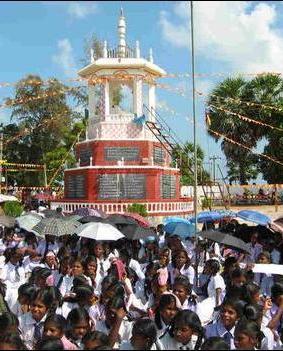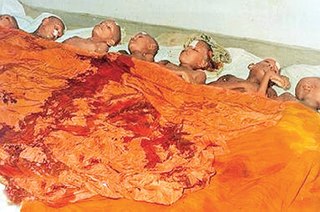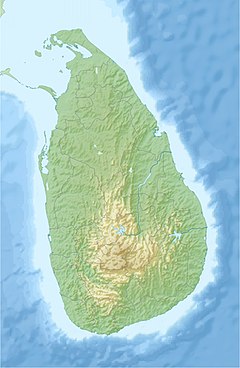
The Special Task Force (STF) (Sinhala: විශේෂ කාර්ය බලකාය Visesha Karya Balakaya; Tamil: சிறப்பு அதிரடிப் படை) is an elite police tactical unit of the Sri Lanka Police specialising in clandestine and covert operations, combat and patrolling in urban areas, combat search and rescue, counterinsurgency and counterterrorism operations, crowd control, executive protection, forward observer, hostage rescue, indirect fire, irregular warfare, jungle and mountain warfare, parachuting, psychological warfare, search and rescue people who are in distress or imminent danger from disaster. serving high-risk arrest and search warrants, special reconnaissance, support military operations, tactical emergency medical, tracking, and unconventional tactics. It was formed in 1983 not as a military force, but rather as a highly specialised armed police unit.
The 1990 Batticaloa massacre, also known as the Sathurukondan massacre, was a massacre of at least 184 minority Sri Lankan Tamil refugees, including infants, from three villages in the Batticaloa District by the Sri Lankan Army on September 9, 1990. Although the government instituted two investigations, no one was ever charged.

The Massacre at Thandikulam is a disputed event which occurred during Sri Lankan Civil War. It took place on 19 November 2006 when suspected LTTE carders exploded an Improvised explosive device targeting a military truck killing five Sri Lanka Army soldiers. Five students of the Thandikulam Agriculture Farm School were also killed in either the explosion or the subsequent gunfight that followed. As of June 2007, investigations are ongoing to ascertain the cause of their deaths.
The Kent and Dollar Farm massacres were the first massacres of Sinhalese civilians carried out by the LTTE during the Sri Lankan Civil War. The massacres took place on 30 November 1984, in two tiny farming villages in the Mullaitivu district in north-eastern Sri Lanka. The Sri Lankan government labeled this as an attack on civilians by the LTTE.
The Mylanthanai massacre happened on August 9, 1992 when 35 minority Sri Lankan Tamils, including 14 children, at Mylanthanai in Batticaloa District in Sri Lanka, were killed.

On June 12, 1991, 152 minority Sri Lankan Tamil civilians were massacred by members of the Sri Lankan military in the village Kokkadichcholai near the eastern province town of Batticaloa. The Sri Lankan government instituted a presidential commission to investigate the massacre. The commission found the commanding officer negligent in controlling his troops and recommended that he be removed from office, and identified nineteen other members of the Sri Lankan military to be responsible for mass murder. In a military tribunal that followed in the presidential commission in the capital city of Colombo, all nineteen soldiers were acquitted.
The 2006 Trincomalee Massacre of NGO Workers, also known as the Muttur Massacre, took place on 4 or 5 August 2006, when 17 employees of the French INGO Action Against Hunger were shot at close range in the city of Muttur, Sri Lanka, close to Trincomalee. The victims included sixteen minority Sri Lankan Tamils and one Sri Lankan Muslim.
Eelam War I is the name given to the initial phase of the armed conflict between the government of Sri Lanka and the LTTE.

Eelam War II is the name given to the second phase of armed conflict between Sri Lankan military and the separatist Liberation Tigers of Tamil Eelam. The war started after the failure of peace talks between the Premadasa government and the LTTE. This phase of the war was initiated by the LTTE who massacred almost 600 Sinhalese and Muslim police personnel after they were ordered by the Premadasa government to surrender to the LTTE. The truce was broken on June 10, 1990 when the LTTE in October expelled all the 28,000 Muslims residing in Jaffna.

The Aranthalawa massacre was the massacre of 33 Buddhist monks, most of them young novice monks, and four civilians by cadres of the Liberation Tigers of Tamil Eelam organization on June 2, 1987, close to the village of Aranthalawa, in the Ampara District of Eastern Sri Lanka. The massacre is among the most notorious and devastating atrocities committed by the LTTE during the history of the Sri Lankan Civil War, and continues to be commemorated 35 years on.
Kokkadichcholai massacre may refer to:
Kokkadichcholai is a village in Batticaloa District within the Eastern Province of Sri Lanka.
Terrorism in Sri Lanka has been a highly destructive phenomenon during the 20th and 21st centuries, especially so during the periods of the Sri Lankan Civil War (1983–2009) and the first (1971) and second JVP insurrections (1987–1989). A common definition of terrorism is the systematic or threatened use of violence to intimidate a population or government for political, religious, or ideological goals. Sri Lanka is a country that has experienced some of the worst known acts of modern terrorism, such as suicide bombings, massacres of civilians and assassination of political and social leaders. Terrorism has posed a significant threat to the society, economy and development of the country. The Prevention of Terrorism Act of 1978 is the legislation that provides the powers to law enforcement officers to deal with issues related to terrorism in Sri Lanka. It was first enacted as a temporary law in 1979 under the presidency of J. R. Jayewardene, and later made permanent in 1982.

The 1987 Eastern Province massacres were a series of massacres of the Sinhalese population in the Eastern Province of Sri Lanka by Tamil mobs and Liberation Tigers of Tamil Eelam (LTTE) during the Sri Lankan Civil War. Though they began spontaneously, they became more organized, with the LTTE leading the violence. Over 200 Sinhalese were killed by mob and militant violence, and over 20,000 fled the Eastern Province. The violence has been described as having had the appearance of a pogrom.
Sexual violence against Tamils in Sri Lanka has occurred repeatedly during the island's long ethnic conflict. The first instances of rape of Tamil women by Sinhalese mobs were documented during the 1958 anti-Tamil pogrom. This continued in the 1960s with the deployment of the Sri Lankan Army in Jaffna, who were reported to have molested and occasionally raped Tamil women.







